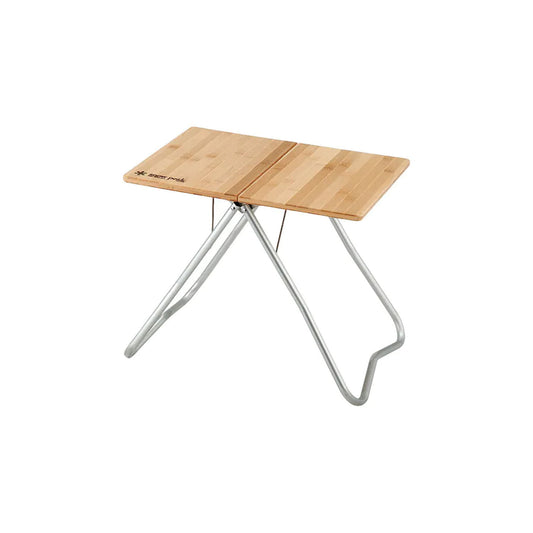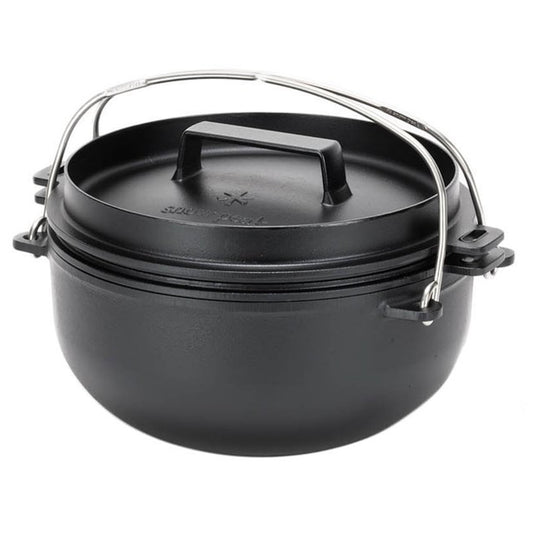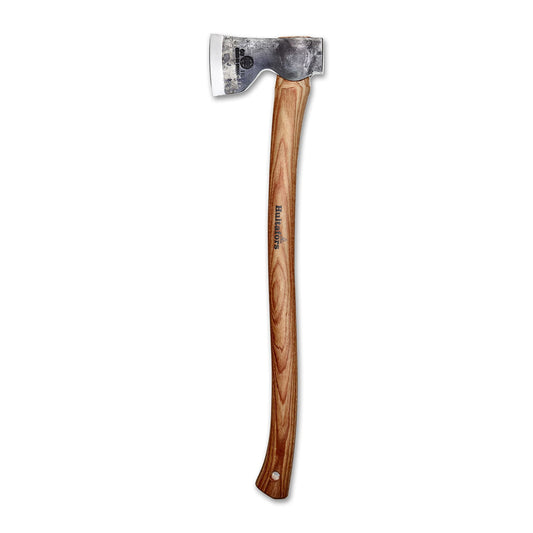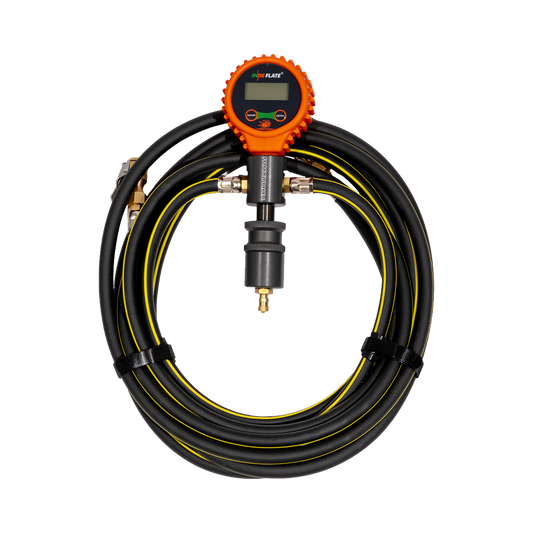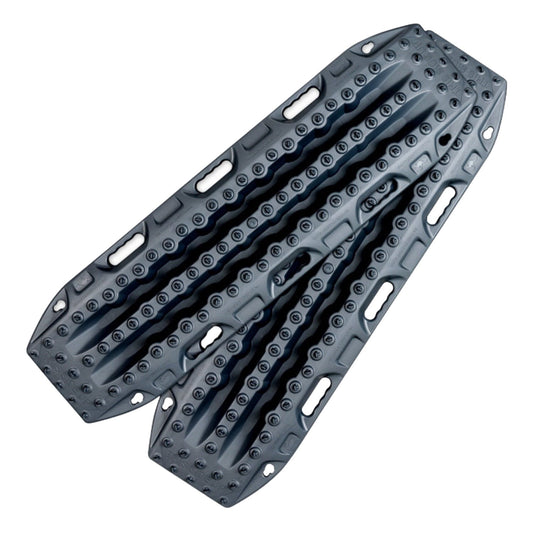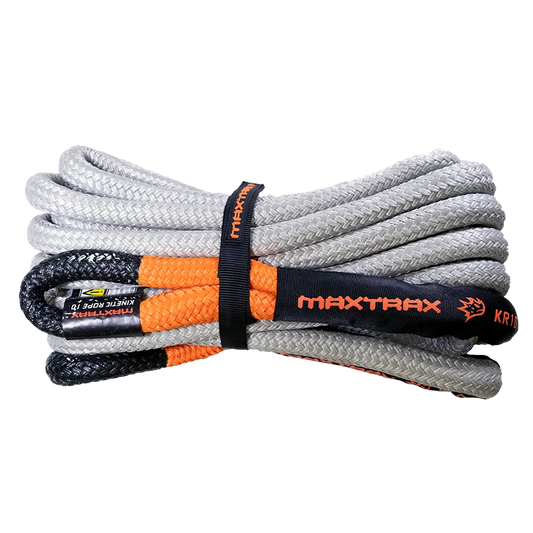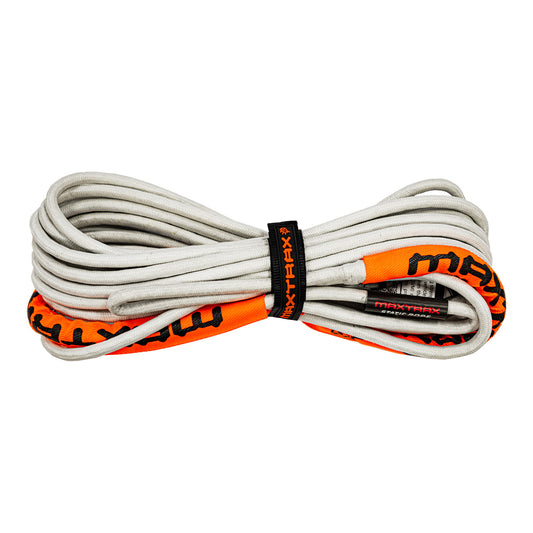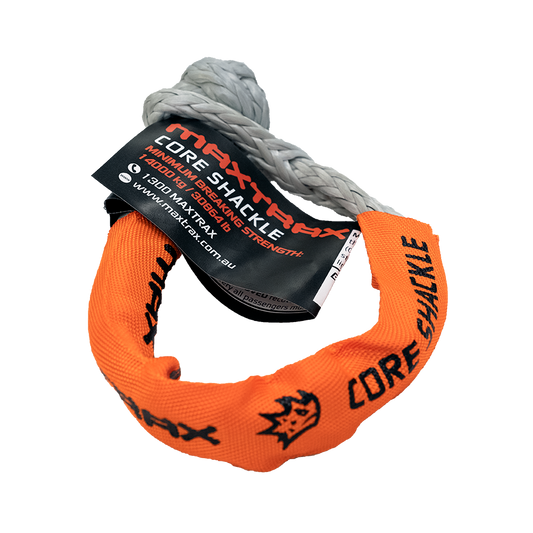Our 76 Series LandCruiser is now well travelled and you can read about some of our trips in the Adventure Curated Journal. It’s taken us across the Bight and the Simpson Desert multiple times, through the High Country, Arnhem Land the Kimberley, Tasmania and many places in between. In that time, we’ve tested and tweaked our setup with a focus on reliability, accessories that will last and keeping the weight down.

Why a 76 Series LandCruiser?
Our previous vehicle was a Toyota LandCruiser Prado 120 Series. It was a great vehicle, but with more frequent rugged travel we were starting to have some issues from the lighter build quality. We bent steering rod arms and one wheel arch began cracking from flex. And while it drove superbly off-road with a light load, the 4 cylinder diesel would run out of steam on the demanding stuff with heavy loads and when towing.
I love wagons and I love the reliability and remote area availability of Toyota parts and know-how so the choice of vehicle for me quickly simmered down to 76 Series LandCruiser vs 200 Series LandCruiser.
For what we do, both would have been a good choice. However, the 76 Series LandCruiser is lighter and back in 2018 the largest Gross Vehicle Mass (GVM) upgrade possible for both vehicles meant the payload for the 76 Series was a lot higher, which was definitely an attraction. But in the end it really came down to preference. The 76 Series LandCruiser isn’t for everyone, but I love the manual transmission, simplicity and ruggedness. For me, when I’m driving it, it feels like I’m a little closer to the adventure.
So we bought a 2018 76 Series LandCruiser GXL model. While I quite liked the idea of the vinyl of the Workmate model, ultimately the dual factory electronic diff locks, power windows, central locking and cruise control won out.

Suspension and Tyres
The Toyota LandCruiser 76 Series comes from the factory with a GVM of 3,060kg, kerb weight of 2,255kg and a payload of 805kg. While 805kg sounds like plenty, it's quickly consumed with permanent modifications like bull bars, rear bars, roof racks and drawers plus the trips specific weights of fuel, water, gear and travellers.
We fitted the Old Man Emu GVM upgrade which increased the legal GVM up to 3,660kg. We did this pre-registration which is a simpler and cheaper process and results in a federally approved upgrade rather than state. After all of the accessories have been fitted our Cruiser weighs ~2,800kg. This gives us 860kg of payload for our remote trips which is enough if we pack carefully.
Staying below GVM is one of the most effective ways of minimising the chance of damaging your vehicle on rough tracks, is safer on the highway and is essential for insurance and staying legal. Staying below GVM is difficult and is a juggle of the choice of initial vehicle and payload, GVM upgrades, keeping your accessories to a minimum and packing carefully.
We've built a number of features into the Adventure Curated app that help you to see the weight of your gear as you make packing lists and whether you are under GVM.

The 76 Series LandCruiser is a basic vehicle, so making the it more comfortable was high on our priority list so we chose to fit Old Man Emu’s BP 51 Shock Absorbers.
They have made an incredible difference to the ride as a bonus they have soaked up some big bumps that on previous vehicles I’ve sustained damage to shock absorbers and other components.
Suspension is trip critical, so while there are other high quality shock absorbers available, few have the availability of Old Man Emu which was a key consideration.

The suspension system in our 76 Series LandCruiser works really well, but with full water, fuel and gear it sags a little in the rear. We already upgraded the leaf packs from the 400kg to 600kg constant load option, and while there is an 800kg model I was worried that it would be too stiff.
The solution was to add an Airbag Man Helper Kit. These are designed to assist the leaf packs to keep the our 76 Series LandCruiser level with the varying loads of full and empty loads and when towing.

JMACX Diff Replacement
As you likely know, since the widening of the 76 Series LandCruiser in the global market to accomodate the V8 engine, the rear axle has been left untouched and as such is narrower. Spacers are illegal and offset rims can put extra strain on wheel studs plus create spare wheel issues. We chose to stick with zero offset rims for the first year with the vehicle before swapping out the rear diff for the JMACX replacement which fixes the issue, plus is stronger.

JMACX High Clearance Plates
In the 76 Series LandCruiser the factory fitted U bolt plate hangs well below the leaf springs. It can be one of the lowest points on the vehicle. By fitting the JMACX High Clearance Plates I’ve gained ~1 inch of clearance at this point which is enough to make it worth doing.

JMACX Radius Arms
While the Old Man Emu suspension kit includes offset bushes to realign the vehicle geometry, the resulting wheelbase is still short of the factory specification. The resulting issue I found was that at highway speeds the steering became floaty. I believe this is a common side effect for most makes of suspension lift for this vehicle.
The only robust solution is to replace the radius arms with longer ones. This pushes the front diff forward and the wheelbase back to factory length. It works surprisingly well. Fo our 76 Series LandCruiser we chose the JMACX Radius Arms.

JMACX Brake Booster
The 76 Series LandCruiser doesn’t have the best brakes and they don’t get better with bigger loads. To help amplify the performance of the existing brakes we fitted a JMACX Brake Booster which helps get ~30% more stopping power.

BFGoodrich KM3s
Originally, I ran 28570R17 Toyo R/Ts. The tyres performed well but I changed configuration for a few reasons. Firstly, the HD steel rims weren’t staying true. Secondly, once I’d corrected the narrower rear wheel track with the replacement JMACX Diff the 285 width tyre would need wider flares to stay legal. Finally, I’ve always loved the narrower 255 width tyre.
We now run KM3s in size 25585R16 with 0 offset. The BFGoodrich KM3 is a rugged and grippy tyre. It’s a mud terrain, but it’s at the quieter end of the noise spectrum. The 25585R16 is a great size tyre for these vehicles in my opinion. It’s 33.1″ in diameter, so it’s nice and tall, but not too heavy and it’s easy to manoeuvre on more tricky lines.

While it is skinnier than many tyres it’s wider than the stock 225 of the LandCruiser 76 Series Workmate model and only slightly narrower than the 265 tyres of the GXL. The 255s also fit neatly and legally within the stock GXL flares with zero offset rims. Speaking of rims, after the issues with the original steel rims I sourced a set of Toyota 76 Series LandCruiser Workmate steel rims and had them powder coated.
My hope was that these rims withstand the abuse of miners and farmers so they would serve us well, and 18 months on I’m happy to report that they haven’t missed a beat. We run the same wheel, offset and tyre combo on our camper trailer to make it easy to share spares.

Vehicle Protection
Originally we fitted a Uneek 4×4 bar. We bought it site unseen, and while the quality was nice it sat really close to the front of the vehicle and the top of the hoops was quite low. While I had no issue, ultimately I was worried that it wouldn’t offer the very best protection for a big animal strike so switched it to an ARB bar.
The ARB bar sits away from the vehicle, sits higher and is made from thicker steel. I think it will offer better protection should we ever need it, but I’m happy to never put this theory to the test! I opted not to fit scrub rails to save width and a little width on the tightest squeezes. While it’s possible I’ll cop some damage here, I think it’s unlikely this will stop the vehicle and I can always get it straightened. For me the weight saving is worth the risk.

Uneek 4×4 Rock Sliders
On our 76 Series LandCruiser we replaced the factory aluminium steps with heavy duty rock sliders/steps made by Uneek 4×4. They are tucked up nice and high, are grippy under foot when wet and have high lift jacking points. They do add weight, but ultimately it is good having the extra protection.

Uneek 4×4 Rear Bar
The rear bar on our 76 Series LandCruiser is also by Uneek 4×4. On the bar we run one spare and two jerry cans. This allows us to expand our diesel load above the 180L tank to 220L with ease. We carry a second spare either in our second row seat storage or on the camper trailer depending on the trip.
Ultimately, it’s now a good bar but we have had a few issues. It has a clever design where the bar holds the weight of the wheel but it connects to the door so it doesn’t need a latch. However, our attaching plate broke twice. They were replaced promptly each time and the designed seems to be improved. Also, the bar lacked forward attachments to the chassis so rotated backwards somewhat over corrugations. We had this fixed locally and have passed on our feedback, but recommend checking these forward attachments are now included if considering this bar.

Engine Protection & Performance
While fitting a quality snorkel is a no brainer, tweaking the engine was the decision I was most reluctant to do. While the 76 Series LandCruiser is de-tuned for mining and farming, reliability is incredibly important to us and I didn’t want to rush in to any change I might regret.
Safari Armax Snorkel
While the factory fitted 76 Series LandCruiser raised air intake is better than nothing, we changed it out with a fully sealed Safari ARMAX Snorkel. These keep water out of the precious engine far more effectively, the ram snorkel head design and four inch diameter body together deliver ~50% more air to the powerful V8.

Safari Armax ECU
To improve the general drive-ability of our 76 Series LandCruiser and to help improve the power to weight ratio when heavily loaded and towing we fitted a Safari ARMAX ECU. While there are plenty of options in the performance space, none seem to have the focus on consistency, reliability and engine longevity that Safari does. We’ve now covered vast distances with this system fitted and it has performed without fault.


Safari Armax Performance Clutch
Unfortunately, the OEM clutch fitted to the 76 Series LandCruiser is prone to failure with increased power. We upgrade the clutch to the 1,100Nm Safari Armax Performance Clutch. It’s robust, but still has a factory feel and engagement point due to the included slave cylinder.

Safari Armax Fuel Pre-Filter
In the 76 Series LandCruiser we’ve upgraded the additional fuel filter to the new Safari ARMAX Fuel Pre-Filter. It’s a high capacity filter that’s designed to work optimally with the ARMAX system.

Safari Armax Oil Separator
We’ve also added the new Safari Armax Oil Separator to help keep the manifold clean.

Manta Exhaust
For our 76 Series Land Cruiser I chose a DPF back, 3″ stainless steel exhaust from local Western Australian company Manta. They have a few options and I also opted for the quietest of the three exhausts. I can now hear the V8, but it’s still pleasant in the cabin on long drives and it doesn’t upset fellow travellers.

The stainless steel is also stronger and obviously more corrosion resistant. I’m hopeful it will last a long time and handle any bumps far better than the original version. The DPF back 3″ exhaust also offers a small performance improvement and assists with keeping our Exhaust Gas Temperatures (EGT) down.

While keeping the DPF won’t deliver the same performance gains, for me it was important to choose a DPF back exhaust. Firstly, it’s the legal option, and I wanted our build to be compliant. But more importantly, this 76 Series LandCruiser is a tool for exploring beautiful wild places. I didn’t want to remove technology that reduces the volume of particles reaching the atmosphere that ultimately leads to the degradation of where we love to explore.
With the ECU fitted our 76 Series LandCruiser has more than enough power, the DPF is fitted with an insulating shield to reduce the risk of fire and additional it’s possible to manually control the DPF burn in a safe place when you are navigating high fire risk areas like overgrown tracks.

Electrical & Solar
At the hub of the electrical system in our 76 Series LandCruiser is a Redarc RedVision system. It’s what is know as a Total Vehicle Management System (TVMS). At the time of install RedVision was being successful used in camper trailers and caravans and our system was the first installed into a vehicle.
Fundamentally, overlanding / touring vehicles have many of the same accessories as campers so the system made great sense. Minimal power cables connect the main battery to the distribution and fuse box and all of the accessories are powered from this point.
The RedVision system has a control panel and app which consolidates countless switches and gauges in a compact space. The complete setup also minimises wiring and makes electrical troubleshooting far simpler.




The lithium battery in our 76 Series LandCruiser is charged by a Redarc Manager 30. It allows charging from DC to DC from the vehicle, solar via the inbuilt regulator or from mains power. You can read more about the Manager 30 in this review.
Paul from Install A Gadget also operates RV Lithium Systems. They specialise in high quality batteries, and can uniquely custom build them in different shapes. We positioned the battery beside the drawers and behind the wheel arch on the passenger side. Paul had originally thought a 100 Ah battery would be the limit for the space, but after building a test box they confirmed they could fit in a whopping 180 Ah unit.
This 180 Ah lithium battery is only just taller than a standard AGM battery. Being lithium powered means it’s equivalent to three 100 Ah AGM batteries, but roughly a quarter of the weight and almost a third of the size. Lithium batteries aren’t cheap, but they far outlast AGMs, so the true cost of long term ownership make them more reasonable. We’re planning on keeping this vehicle for a long time, and for us the benefits in performance, weight and size are worth it.


While we typically don’t use extremely demanding accessories, we like to be able to charge all of our cameras, laptops and other devices at once, so have opted for a reasonably large 1,500W inverter.

To operate our camper trailer brakes we’ve fitted our 76 Series LandCruiser with a REDARC Tow-Pro Elite. The main unit is tucked away under the dash and we’ve located the switch centrally so the driver or passenger can manually activate the brakes if needed. We recycled the cigarette socket as a neat mounting location. You can read more about the

UHF
We pulled our Icom IC-450 UHF radio from our Prado, it’s a solid, made in Japan, unit. We’ve mounted it centrally so it reaches the passenger and driver with less stretching. Next to that is our Bury iPhone Cradle which connects to a RFI CDQ7195 4G Antenna.

Cel-Fi Go
We’ve mounted two RFI Antennas. The CDQ7195 connects to a Bury iPhone cradle, and the CDQ5000 to our Icom IC-450 UHF radio. In the city/country pack the CDQ5000 comes with the CDQ34, a short whip which is designed for getting in carparks, but I think we’ll use more to increase driver vision when we don’t need 5dBi of gain.

Cabin
For testing our Trip Planner app beta and mapping we use an iPad Air. Originally, we used a double RAM suction mount, but the iPad would sometimes get too hot. We still a RAM mount but have now located the iPad left of the gear lever.
We’ve fitted a Cruiser Consoles Centre Console. It’s definitely a big upgrade over the factory plastic box and gives a comfy elbow rest, plenty of storage and most importantly cup holders! The cup holders are big enough for our favourite Snow Peak H450 coffee mugs or a water bottle and the tray is perfect for my Leatherman and other odds and ends.

We’ve spoken to people that found Dynamat on the doors made the biggest improvement in cabin noise in the 76 Series LandCruiser. Being mindful of weight, we’ve started there.


While we were at it, we added some Cruiser Consoles Speaker Pods to accommodate some basic, but much improved speakers. The sound deadening and improved sound has made a massive difference.

Fuel & Water
While the factory-fitted 130-litre fuel tank isn’t tiny, for long trips it’s not enough, so we fitted a 180-litre aluminised steel Long Ranger tank which is designed to avoid a decreased departure angle.


Our first water tank is a 40L tank from Long Ranger. It’s an underbody tank that tucks high in the chassis on the driver’s side. It’s an excellent spot for getting the weight forward and low in the 76 Series LandCruiser.
The second water in our 76 Series LandCruiser is also 40L, a poly tank that sits right on the rear axle. It also gets the weight low and forward and the tank fits with or without the rear seats installed.
So in tanks, we have a total of 80L of water. If we’re towing we have a 150L tank in the camper trailer as well. If we need extra water when not towing, we have a stack of sturdy 6L bladders we pack in a duffle and position on the floor in the second-row storage. They’re really used to transfer into the tanks, and when they’re empty they take up little space which is a bonus.

Rear Setup
The core of the rear setup of our 76 Series LandCruiser is a pretty standard setup with twin drawers stacked on the right and the fridge on a low slide on the left. It gets the fridge low for easy access and avoids the weight and bulk of a drop-down slide.

Above our drawers, we’ve fitted an easy-to-remove shelf. We can store 10 of the large Snow Peak Multi Containers. They are deceivingly big – one can hold 22 cans of beer or six bottles of wine! We’ve fitted small labels to each to make it easy to find things. We also left a gap the same width as a Multi Container so we have somewhere to put them when accessing them. It works well – we can pull out our coffee kit and leave it on the shelf while we brew on the bamboo bench.

In the rear setup of our 76 Series LandCruiser, we’ve built sleeves to accommodate the Snow Peak IGT kitchen system. Half extended the Snow Peak IGT Frame, and Snow Peak IGT Extension bench can be used for quick stops. Alternatively, they can be removed altogether, fitted with legs and connected for a large kitchen positioned back from the vehicle for less congestion or a better view!

Second Row Seat Setup
We travel as two, so removing the second-row seats from our 76 Series LandCruiser was an easy decision to make more space. I’ve opted to keep it to simple shelves rather than more permanent drawers so I can switch the seat back in when needed. It usually stays in touring mode, but in ~45 minutes, I can lift out the shelves, unbolt the forward cargo barrier and bolt in the seat.
A forward cargo barrier is a dual-position option made by Hayman Reese. The shelves are carpeted marine ply, and fingers extend into the gaps in the rear and forward cargo barriers.
I’ve fitted the second spare inside to allow us to carry an additional 40L outside on the rear bar for our remote trips. We have a matching spare on the camper, so when we’re towing, I’m happy with two spares, so remove this internal one. We made a blank that bolts into the spare gap and gives an entire middle row of storage in this configuration.
In the picture below, you can see hinges on the top shelf, these are to allow this shelf to be installed and removed quickly in the narrow gap up high.
Storage-wise, we usually store heavy stuff, like our fire pit, firewood (if we are carrying some) as well as bulky gear down low. The middle shelf is for our gear. Gen and I have a side each and a couple of smaller duffle bags each to keep things organised. The top shelf is for our camp chairs and coffee table.
You’ll hear a lot of people talking about ‘everything having a place’, and on long trips in particular, it makes life easy. With our setup, I’ve also tried to give everything a bit of room. What I mean by this is that things aren’t stacked on top of each other. It means, for the most, part, you don’t need to move items to get what you need. When it comes time to pack up, it also means that whatever is ready can go immediately without following a particular packing sequence.
Excluding the second spare wheel, the three shelves and extra cargo barrier weigh the same as the seat we remove. One of the significant benefits of the extra barrier is that we don’t have to tie anything in place to stop it from coming forward if we hit a big bump off-road or were to have an accident on the highway.

Roof Rack, Awning & Rooftop Tent
On our 76 Series LandCruiser, we’ve mounted ROLA Heavy Duty cross bars. Rather than the listed feet, we’ve used ROLA’s smallest ones with the 20mm spacers. They have a high load rating and are light, plus they are handy for carrying sea kayaks, whitewater kayaks, canoes, surfboards and rooftop tents. We find cross bars the best.
We love hardshell rooftop tents. And while we’ve tested many models for Adventure Curated Reviews our current go-to is the iKamper Skycamp 2X. It weighs just 55kg, has plenty of room for the bedding to stay up top, plus it’s comfy for my wife Gen and me (I’m 6’3″).
On some trips, we just run the rooftop tent on our 76 Series LandCruiser, and when we’re using our camper trailer, we use the same iKamper on it to be more cost-effective and save on storage issues.



Recovery Gear
Consistently, our most used recovery gear is our MAXTRAX. While heavier, we upgraded to the MAXTRAX Xtreme for durability. We carry four either on the rear wheel of our 76 Series LandCruiser or up on the rack.
For kinetic recoveries and winching, we’ve fitted a rated ARB recovery point to the front of our 76 Series LandCruiser. As a rear recovery point with fitted our 76 Series LandCruiser with a MAXTRAX Recovery Hitch which is designed for use with soft shackles.
In the right gull locker of our 76 Series LandCruiser, we’ve mounted a variety of Maxtrax soft shackles, Kinetic Ropes, Anchors and a Winch Ring. We’ve also mounted our ARB compressor hose, Warn winch control, axe, Silky saw and gloves. Quick Fist makes the mounts and they are sturdy and easy to access.
We’ve previously experienced reliable service from ARB’s compressors and opted for their twin compressor for our 76 Series LandCruiser. We bolted it into the side of the drawer unit behind the wheel arch. There’s plenty of air space to help keep the compressor cool plus the space ventilates forward through the cargo barrier to the main cabin. We leave the airline connected, ready, to speed up airing up.
To help with tyre inflation and deflation, we use a Maxtrax Indeflate, which allows for the deflation and inflation of two tyres at once. We hang it off the front or rear bar to do other things while waiting. It stores neatly in the recovery locker on the side of our 76 Series LandCruiser.





Inside the ARB bar on our 76 Series LandCruiser, we bolted a Warn ZEON 10-S winch. We make lots of trips with one vehicle, so for us, it is great peace of mind to have a quality winch. We chose the Spectra version because, at 27kg, it is 17kg lighter than the steel version, plus we find synthetic ropes safer and easier to handle than wire ones.
We’ve also fitted a Factor 55 Fairlead and Flatlink E. The Flatlink allows for safer winching connections by removing the hook. This eliminates the chance of disconnection through rollout, plus it also makes it hard to cross-load and weaken the connection.
In our winching kit we also carry Maxtrax Static Ropes for anchors, a Maxtrax Static Rope for reaching distant anchors and a Maxtrax Winch Ring 120 for when we need to do a double line pull to reduce the load on the winch.

If you're interested in a complete new build, or additional accessories for your vehicle, we recommend getting in touch with the team at Ultimate 4WD.



